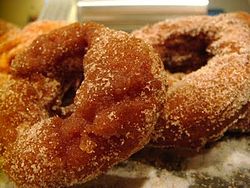 Cider doughnuts topped with cinnamon | |
| Type | Doughnut |
|---|---|
| Place of origin | United States |
| Main ingredients | batter, cinnamon, nutmeg, apple cider |
Cider doughnuts or apple cider doughnuts are American cake doughnuts that get their flavor from cinnamon, nutmeg and apple cider used in the batter. [1] They are a harvest tradition in autumn in the northeastern United States and are sometimes sold at cider mills. They are often paired with apple cider, and may be covered with cinnamon and/or granulated sugar. [2]
Contents
Cider doughnut season coincides with the harvest season for apples, beginning in September and lasting through November or December. According to Food & Wine , "year-round" cider doughnuts are likely to suffer from a lack of fresh-pressed cider and are best bought fresh, before they dry out. [3] [4] The doughnuts are sold in grocery stores as early as August and have also been offered as a seasonal item at Dunkin' Donuts. [5] [6] [7]
They are a common accompaniment to leaf peeping and apple picking trips. [3]


